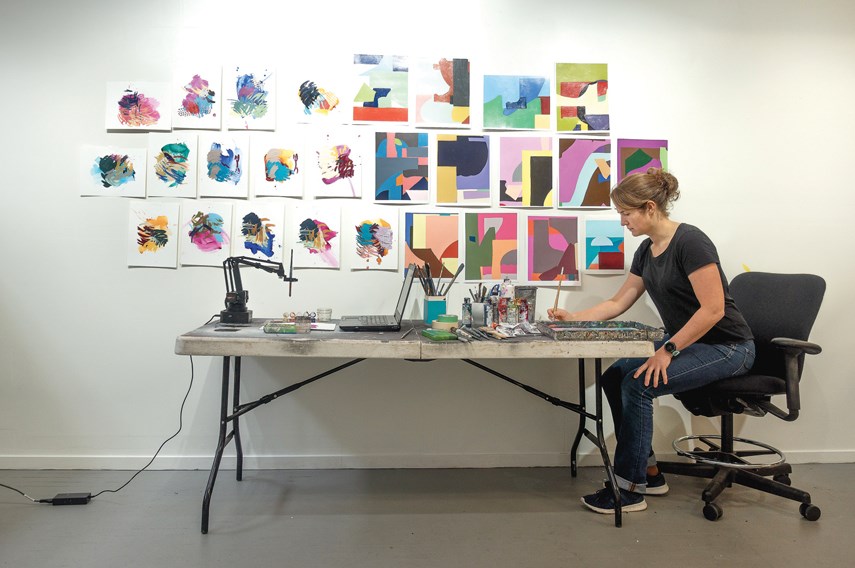2018 Eastside Culture Crawl, annual four-day celebration of visual arts, design and crafts, runs Nov. 15–18 in 500+ artists studios, homes, and garages throughout Vancouver’s Eastside (culturecrawl.ca).
“The mediator between the head and hands must be the heart!”– Metropolis, 1927
It wasn’t the question – it was what it implied.
“Can you sign your robot paintings?” her friend asked.
He was inquiring about North Vancouver artist Joanne Hastie’s practise of applying paint to paper by means of a robot arm. But nestled in that innocuous sounding question was an accusation: the robot painted those, not you.
There was a time when that query would’ve been unthinkable outside an Isaac Asimov novel or a particularly highbrow episode of The Jetsons. But for Hastie, who works with a robot as surely as she works in acrylics, it’s a question she’s resigned to answering.
“I chose the colours, I programmed each brush stroke. I was the one who had my trigonometry textbooks out to figure out how to make a brushstroke look like a curve and not a robotic straight line,” she explains. “I feel OK with signing it.”
In preparing for this year’s Eastside Culture Crawl, Hastie is prepared to be an educator.
“Most people don’t get it,” she says of the robot art. For others, there’s anger over the robot, as though Hastie was the artistic equivalent of the Ford Motor Company, using her robotic hand to shut down galleries and shove artists out of work.
In part because she’s constantly refining the code that directs every drip, dip and brush stroke, the arm hasn’t saved Hastie any labour, she reports.
“It takes me significantly longer to program a robot to paint than it does for me to just paint it by hand,” she says.
And while the arm is precise, Hastie hasn’t yet found a way to program out the possibility of the unexpected.
“Believe it or not, I find more happy accidents with using a robot because the robot is layering paint and it’s not going to stop unless I unplug the thing.”
Hastie comes from an engineering family where she was taught to examine everything around her in order to comprehend its design.
Her upbringing blessed her with a particular form of double vision: she can see the beauty of the stars and accurately estimate their chemical tonnage.
She used her first paycheque as an engineer to buy paint supplies, she recalls.
“They’re different communities, different thought processes so it’s always been interesting straddling both engineering as well as art.”
While some artists tend to feel the workaday world is a time-sucking toil that detracts from their creativity, Hastie is equally enthusiastic about her work in fine arts and her job as an R&D engineer, happily working as Superman in both worlds and Clark Kent in neither.
“I actually took my husband’s name so as an engineer I was Joanne Hughes and as an artist I was Joanne Hastie,” she says. “After a couple years of doing that I realized it was too difficult to be two separate people.”
For 12 years Hastie split her time between recreating cityscapes and landscapes and pursuing her engineering work. Her worlds didn’t collide until she laid her hand on a robotic arm.
It was the type of arm you’d usually see assembling mid-size sedans together. But Hastie considered the mechanism’s artistic implications, “as soon as I touched it,” she says.NSNW Entertainment Manual PQ
Unexpectedly, the arm led her in a different artistic direction.
She’d never created non-representational art before, she says. But with the arm she was free to explore abstracts, examining the effect if the brush is a centimetre too high or if it takes on a dab of paint more than what was programmed for.
“The outcome is pretty neat to me,” she says.
Watching what the arm can do is hypnotic, Hastie says. But what is even more intriguing is what it might do.
Hastie is currently investigating machine learning. She envisions a robot utilizing her personal preferences for composition and colour combination.
“The dream is to have machine learning and robotics work together,” she says.
And between the head and the hands, Hastie will continue to mediate.



